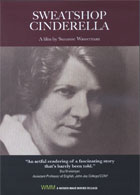
Sweatshop Cinderella 2010
Distributed by Women Make Movies, 462 Broadway, New York, NY 10013; 212-925-0606
Produced by Suzanne Wasserman
Directed by Suzanne Wasserman
DVD, color, 27 min.
College - Adult
Jewish Studies, Biography, Women's Studies, Literature
Date Entered: 10/07/2010
Reviewed by Gary Handman, University of California BerkeleyWriter Anzia Yezierska's life and work is grist for a potentially great documentary film. It's a life full of high melodrama: economic and emotional peril, fulfillment and disappointment, rapid artistic success and an equally rapid fall into largely self-imposed anonymity. Born in Poland in the 1880s, Yezierska immigrated to New York a decade later as part of the late-19th Century diasporic tidal wave of Eastern European Jews. By the end of her second decade in the US, she had fled from the religiously and psychologically suffocating confines of her father's home, married and divorced several times, had several children, earned a teaching degree from Columbia University, worked briefly as a social worker in San Francisco, taken up writing, and entered into an intense (although largely epistolary) relationship with philosopher and educator John Dewey. Her short stories and novels, detailed and evocative chronicles of immigrant life on the Lower East side (particularly the lives of immigrant women), were published in a wide variety of popular magazines throughout the 1920s. This popularity brought Yezierska to the attention of Sam Goldwyn, who bought the screen rights to her story collection, Hungry Hearts and produced a film based on them in 1922.
Yezierska's years in Hollywood, which should have been a personal triumph--Goldwyn offered her a staggering $10,000 to write future scripts--were not; the "Sweatshop Cinderella" (as the studios hyped her) was miserable living among the palm trees, the Hollywood hype and artifice. Returning to New York, she continued to write, but as the Depression descended, the public's taste for Yezierska's realistic depictions of ghetto poverty and despair declined. The remaining decades of her life were spent holed up in a tiny rooming house on the Upper West Side, largely forgotten until after her death in 1970.
So, what has filmmaker Suzanne Wasserman made of this fascinating life? Precious little, unfortunately. Even the most accomplished and disciplined of documentary filmmakers would have found it difficult to cram a life as filled with drama and incident into under a half-hour. Wasserman fails almost completely at the task. With a subject this complex and a film this lean, every minute, every image should count. Wasserman squanders her time at almost every turn. For some peculiar reason, the filmmaker chooses to desultorily inject her own life, her own longing into the mix ("Could examining the past exorcize its spell over me?"). Worse, these forays into the personal are highlighted by the inclusion of family photos and home movies that mean almost nothing to the viewer and do nothing to illuminate the subject at hand. We never learn exactly why the filmmaker is so earnest about recovering and holding onto her own past, and in a film this short, we don't really want to.
Structurally and technically, there are also serious problems with Wasserman's film. The narrative veers between stiff, clumsy, and trite ("Anzia had found her subject: the haunting pull of her own past"). The use of numbingly familiar stock footage to illustrate or underscore the narrative is similarly detracting (old Jews praying; immigrants lumbering through the gates of Ellis Island--the same damn footage that appears in almost every doc on European immigrants, it seems). In one case, the very same generic footage is used in two sequences--unconscionable. The viewer gets the uneasy feeling that Wasserman has never watched or studied a competent documentary in her life; she seems to be awkwardly inventing her filmic vocabulary as she goes along. Finally--OK, this is a bit of a quibble, I'll admit--throughout the film one of Wasserman's principal experts, Professor Alice Kessler-Harris, has an enormous, sometimes oscillating grey hair on the lapel of her dark-colored coat which absolutely drove me nuts. One has to wonder if Wasserman or her cinematographer ever looked through the lens at their subject.
Not recommended